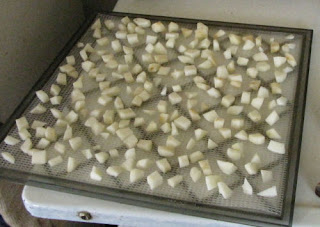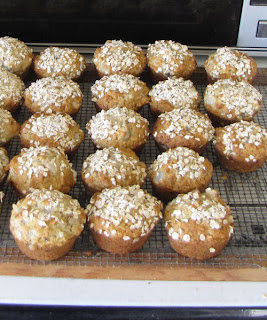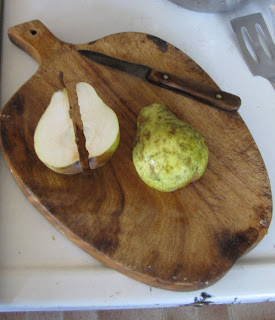If you have a pear tree, or access to one, you've already found that, in a good year, once the pears start to ripen there are more than you can deal with. Here are a few of my favorite fast, easy ways to serve pears that will help make the pile disappear.
Pears Plain
Just eat them out of hand! No need to peel if the skin is clear.
Pears in Lime Jello
This is a classic, but kids love it. (Adults do too!) You do have to remember to mix up the jello a few hours ahead of when you want to serve it. Prepare lime jello (regular or sugar free) according to the directions. Stir in pear chunks. If you stir them in when the jello is just starting to set, they won't float, but if the goal is to feed a hungry family... who cares!
 pear half garnished with a pickled crabapple (photo by jhy) pear half garnished with a pickled crabapple (photo by jhy) |
Pears with Garnishes
Plain pear halves can be served with just a bit of something to enhance the mild and sweet flavor of the pear. This can even be quite elegant if served on a lettuce leaf.
1. Add a
pickled crabapple, and drizzle the pear with the red juice.
2. Add a strawberry and drizzle with chocolate sauce
3. Add a dollop of some jelly, preferably with a tart flavor- mint or
crabapple
4. Drizzle with Nutella
Pears and Cheese
Pear chunks mixed with various kinds of greens and sprinkled with crumbles of a strong flavored cheese such as bleu cheese, Gorgonzola, Havarti, etc. make a fancy, but easy, salad.
Pears and Spreads/Dips
1. Pears smeared with peanut or other nut butters make a quick snack.
2. Cut pears into matchsticks and serve with bleu cheese dressing as a dip
Pear "Waldorf" Salad
I think pears go particularly well with pecans. Make a Waldorf style salad of firm pear chunks, pecans and celery. Mix with just enough mayonnaise or Miracle Whip to bind.

 dish of autumn cobbler with whipped topping
dish of autumn cobbler with whipped topping  autumn cobbler prepared fruits (photo by jhy)
autumn cobbler prepared fruits (photo by jhy)  autumn cobbler filling, before baking (photo by jhy)
autumn cobbler filling, before baking (photo by jhy)  autumn cobbler in the pan (photo by jhy)
autumn cobbler in the pan (photo by jhy) 



















